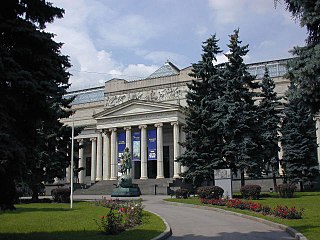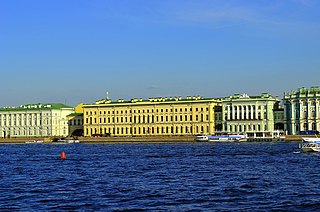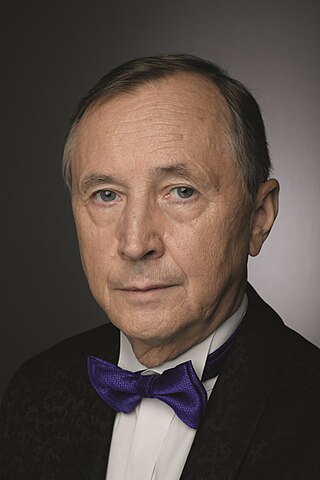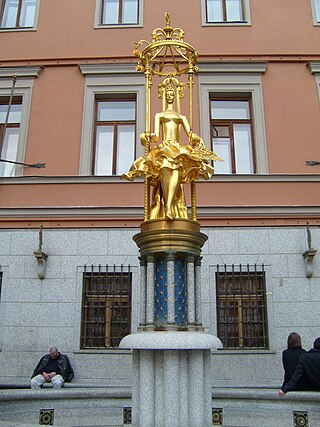
The Pushkin State Museum of Fine Arts is the largest museum of European art in Moscow. located in Volkhonka street, just opposite the Cathedral of Christ the Saviour. The International musical festival Sviatoslav Richter's December nights has been held in the Pushkin Museum since 1981.

Russian literature refers to the literature of Russia and its émigrés and to Russian-language literature. The roots of Russian literature can be traced to the Middle Ages, when epics and chronicles in Old East Slavic were composed. By the Age of Enlightenment, literature had grown in importance, and from the early 1830s, Russian literature underwent an astounding golden age in poetry, prose and drama. Romanticism permitted a flowering of poetic talent: Vasily Zhukovsky and later his protégé Alexander Pushkin came to the fore. Prose was flourishing as well. Mikhail Lermontov was one of the most important poets and novelists. The first great Russian novelist was Nikolai Gogol. Then came Ivan Turgenev, who mastered both short stories and novels. Fyodor Dostoevsky and Leo Tolstoy soon became internationally renowned. Other important figures of Russian realism were Ivan Goncharov, Mikhail Saltykov-Shchedrin and Nikolai Leskov. In the second half of the century Anton Chekhov excelled in short stories and became a leading dramatist. The beginning of the 20th century ranks as the Silver Age of Russian poetry. The poets most often associated with the "Silver Age" are Konstantin Balmont, Valery Bryusov, Alexander Blok, Anna Akhmatova, Nikolay Gumilyov, Sergei Yesenin, Vladimir Mayakovsky, and Marina Tsvetaeva. This era produced some first-rate novelists and short-story writers, such as Aleksandr Kuprin and Nobel Prize winners Ivan Bunin, Leonid Andreyev, Fyodor Sologub, Yevgeny Zamyatin, Alexander Belyaev, Andrei Bely and Maxim Gorky.

The State Hermitage Museum is a museum of art and culture in Saint Petersburg, Russia. It is the second largest art museum in the world by gallery space. It was founded in 1764 when Empress Catherine the Great acquired a collection of paintings from the Berlin merchant Johann Ernst Gotzkowsky. The museum celebrates the anniversary of its founding each year on 7 December, Saint Catherine's Day. It has been open to the public since 1852. The Art Newspaper ranked the museum 10th in their list of the most visited art museums, with 2,812,913 visitors in 2022.

Tver is a city and the administrative centre of Tver Oblast, Russia. It is situated at the confluence of the Volga and Tvertsa rivers. Tver is located 180 kilometres (110 mi) northwest of Moscow. Population: 416,216 (2021 Census).

The Order of the Red Banner was the first Soviet military decoration. The Order was established on 16 September 1918, during the Russian Civil War by decree of the All-Russian Central Executive Committee. It was the highest award of Soviet Russia, subsequently the Soviet Union, until the Order of Lenin was established in 1930. Recipients were recognised for extraordinary heroism, dedication, and courage demonstrated on the battlefield. The Order was awarded to individuals as well as to military units, cities, ships, political and social organizations, and state enterprises. In later years, it was also awarded on the twentieth and again on the thirtieth anniversary of military, police, or state security service without requiring participation in combat.

Saint Petersburg State University is a public research university in Saint Petersburg, Russia. Founded in 1724 by a decree of Peter the Great, the university from the beginning has had a focus on fundamental research in science, engineering and humanities.

The State Tretyakov Gallery is an art gallery in Moscow, Russia, which is considered the foremost depository of Russian fine art in the world.
The Chelyadnins (Челяднины) were an old and influential Russian boyar family who served the Grand Princes of Moscow in high and influential positions. They were descended from Ratsha, court servant (tiun) to Prince Vsevolod II of Kiev.

The Moscow Art Theatre was a theatre company in Moscow. It was founded in 1898 by the seminal Russian theatre practitioner Konstantin Stanislavski, together with the playwright and director Vladimir Nemirovich-Danchenko. It was conceived as a venue for naturalistic theatre, in contrast to the melodramas that were Russia's dominant form of theatre at the time. The theatre, the first to regularly put on shows implementing Stanislavski's system, proved hugely influential in the acting world and in the development of modern American theatre and drama.
Golden Age of Russian Poetry is the name traditionally applied by philologists to the first half of the 19th century. This characterization was first used by the critic Peter Pletnev in 1824 who dubbed the epoch "the Golden Age of Russian Literature."

Dubrovsky is an unfinished novel by Alexander Pushkin, written in 1832 and published after Pushkin's death in 1841. The name Dubrovsky was given by the editor.
Dostoevsky Omsk State University, usually referred to as Omsk State University (OmSU) was founded in 1974 in the city of Omsk, Russia. The two original departments and 40 professors have grown to 13 departments and a 1000-member faculty. The university has graduated more than 25,000 students. OmSU embraces its connections to the world and develops international relations with the universities of Europe, the United States, Mexico, Japan, China, Kazakhstan and other countries. Such cooperation led to the establishment of the Centers for Chinese, Kazakh and Ibero-American Studies which in its turn flows into the development of study and research abroad programs that provide the opportunity to conduct independent projects in a foreign country.

The Maxim Gorky Literature Institute is an institution of higher education in Moscow. It is located at 25 Tverskoy Boulevard in central Moscow.

Nikolai Petrovich Burlyayev is a Soviet and Russian actor and film director. Born into a family of actors, Burlyayev started his career in film and theatre when he was still a child. He is best known for his title role in Andrei Tarkovsky's Ivan's Childhood. He worked with Tarkovsky again four years later, as Boriska in Andrei Rublev.

Russian philosophy is a collective name for the philosophical heritage of Russian thinkers.

The Rossica Translation Prize is a biennial award given to an exceptional published translation of a literary work from Russian into English. It is the only prize in the world for Russian to English literary translations.
Chichrerin House was a historical landmark building located at Nevsky Prospekt 15 in Saint Petersburg, Russia. It is also known as Kosikovsky House, Elisseeff House and Barrikada cinema theater.

Alexander Nikolayevich Bourganov is a Russian sculptor, a National Artist of Russia, and a member of the Russian Academy of Fine Arts. His recent works include a monument to Alexander Pushkin located at George Washington University in Washington DC (2000); a statue of John Quincy Adams, the first U.S. Ambassador to Russia and later President of the United States, located in front of the U.S. Embassy in Moscow (2008); and a statue of poet Walt Whitman located on the campus of Moscow State University (2009). In 2001 his studio in Moscow was given the status of a State Museum, known as Bourganov's House. His other works around Moscow include a series of fountains and statues on Ukrainsky Boulvar, near the Hotel Ukraine.

Third National Art Exhibition "Soviet Russia" became a main national art event of 1967, as well as one of the largest Soviet art exhibitions of the 1960s. The exhibition took place in Manezh Exhibition Hall.















